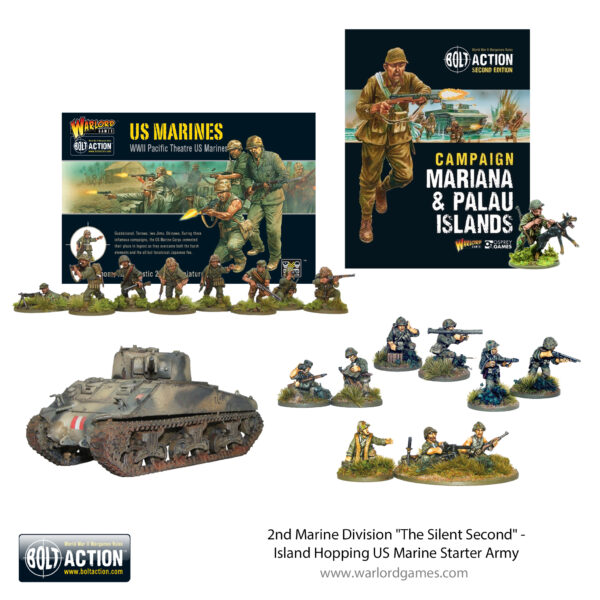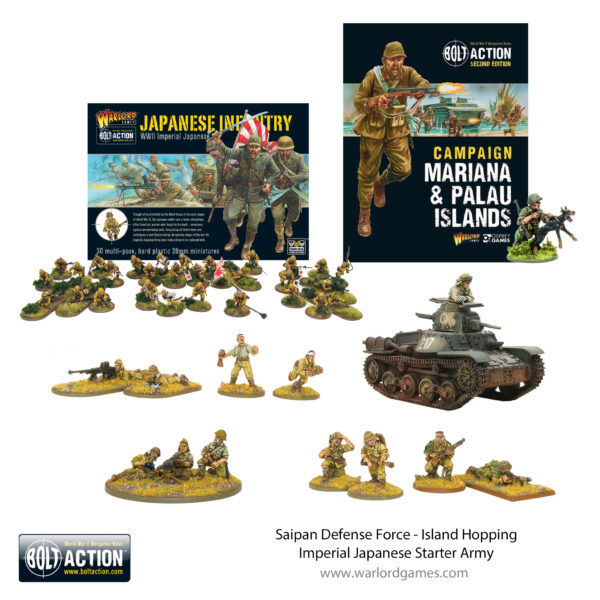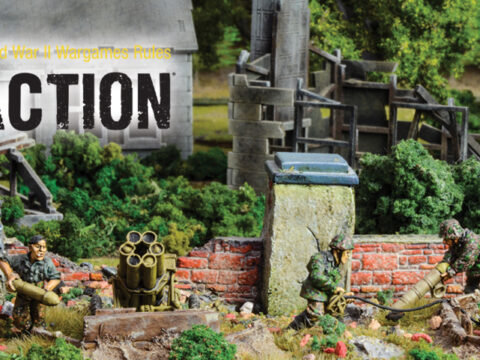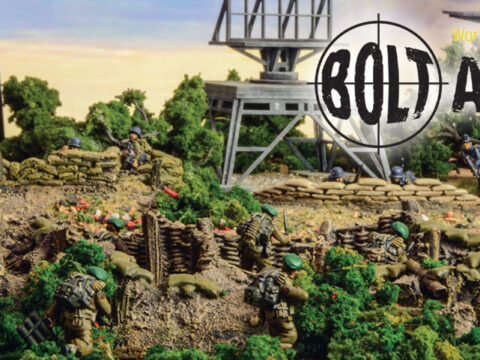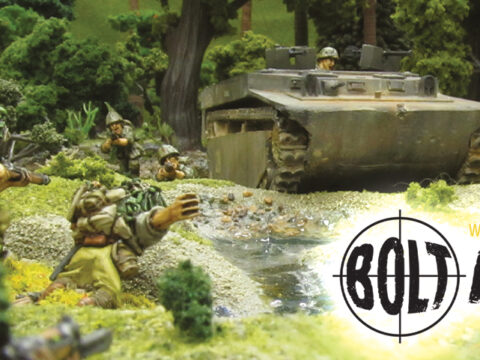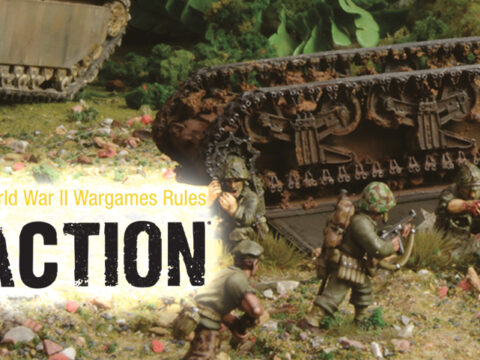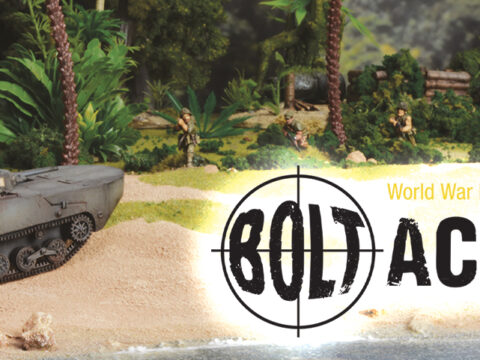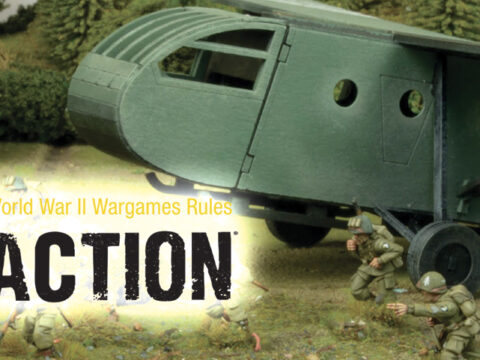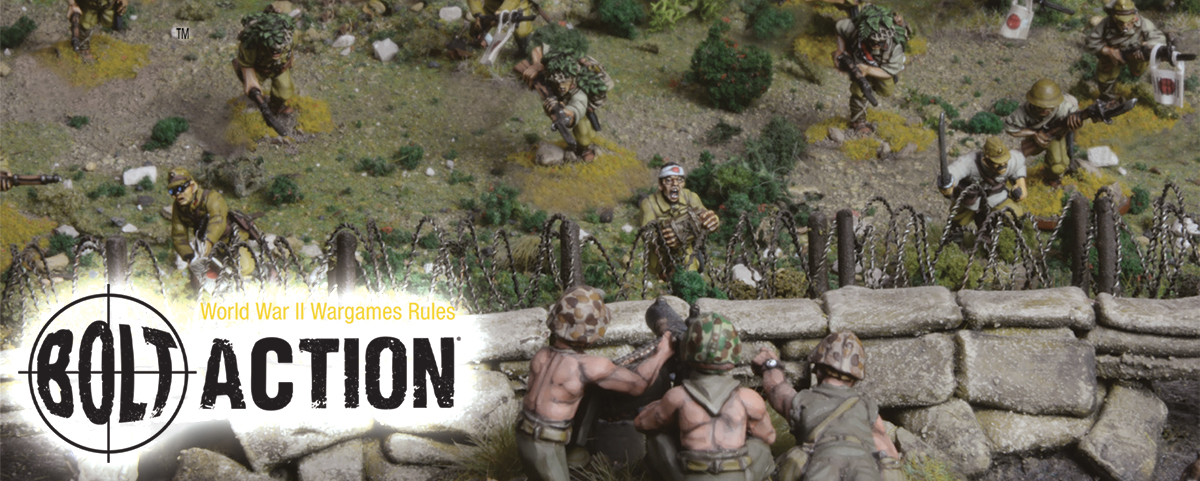
Our Bolt Action Campaign books are chock full of history and scenarios, so much so that sometimes not everything can make the cut. Thankfully we are able to use this platform to share some of these ideas and scenarios with the Warlord Community.
The following is a scenario that did not quite make it into the forthcoming Campaign Book, Marianas and Palau Islands, along with its historical background. If you try out the scenario yourself, we’d love to hear your feedback!
Tinian – Drive to the South and the Cliff J+7 July 31
Colonel Ogata, after failing to stop the Americans at the beaches, developed plans for a defence line from Gurguan Point to the inter-island radio station, then to the centre of Asiga Bay. Delaying troops would occupy positions in front of the line to give troops time to prepare defences. Ogata decided to withdraw to the redoubt in the southeast corner of the island.
The marines now had the exhausting job of “bush beating” through the cane fields in terrific heat, humidity, and frequent monsoon downpours, sometimes under distant small fire and under the threat of sudden close contact with entrenched troops, mines or booby traps. A Japanese blocking position in hidden caves was left in the north at Mount Maga, 2000 yards southeast of White Beach two. The Japanese withdrew after a day of fighting. The important Ushi Airfield was also abandoned and two days later the first P-47 landed on the cleaned up runway. On 27 and 28 July the marines made large gains against light resistance in a push toward Tinian Town. The resistance encountered consisted mostly of isolated machine guns or individual riflemen employing hand grenades. Central Tinian was open sugarcane fields with gently undulating terrain which permitted tanks to be used with far greater effectiveness than had been the case on Saipan.
Japanese resistance gradually stiffened as the Americans approached the Japanese last main defensive line. On the right, the 4th Division on the 30th assaulted a series of 75mm gun positions in well-camouflaged cave positions on the west coast and after reducing them pushed on into and through Tinian Town. Minefields on the town’s outskirts and along the beaches of Sunharon Bay slowed the advance a little, but the town itself had been reduced to rubble by naval gunfire and had been evacuated. On the left, the 2nd Division faced tougher progress as it came abreast the Masalog hill mass but was taken by combined infantry-tank assaults.
The Americans in four days had pushed their lines ahead about 10,000 yards on the left and 4,000 on the right. Colonel Ogata had relinquished his mid-island line of defence almost as soon as it had been established, and on the night of 29 July, he moved his command post to a shrine in a cliff near Marpo Point. Seeing his delaying actions crumble before the advancing Americans, he ordered all Army and Navy forces to assemble on the southern tip of the island to defend the ridge line there.
According to a 4th Division intelligence report of 7 August, based upon interrogation of Japanese prisoners, Colonel Ogata issued his last order on 29 July, which directed Army and Navy units to assemble in the wooded ridges of southern Tinian, to make their last stand. Captain Oya, supposedly, issued his own orders to the naval troops that they were to defend the high ground of southeast Tinian.
Nightfall of 30 July found the two Marine divisions drawn up on a line just north of the hill mass that dominated the southern tip of Tinian. The Japanese were compressed in the southern end of the island. South of them was about a mile of flat land that terminated in an abrupt wooded escarpment rising to a high plateau. Here Colonel Ogata had elected to make his last desperate stand. The area consisted mostly of an oblong mountain mass about 5,000 yards long and 2,000 wide running generally in a northeast-southwest direction. This high ground had steep ridges and cliffs around its shoulders supporting the comparatively gentle slopes along the top that were covered with thick bush and rock. One side faced the flat land around Tinian Town, the other met the sea on the east coast and was impossible to scale. In the centre, was a single winding road in a double hairpin pattern leading to the plateau. Colonel Ogata’s defence line of cliff line gun positions and infantry works was on the forward north-western slopes of the hill mass.
On the morning of 31 July the marines attacked as before with two divisions abreast, the 4th on the right, 2nd on the left. Before the jump-off, two battleships (Tennessee and California) and three cruisers (Louisville, Montpelier, and Birmingham) fired about 615 tons of shells into the area. It was the most powerful bombardment the Japanese had experienced so far in WWII. At 0710, the ships ceased firing for a period of 40 minutes, to allow a bombardment by 126 aircraft. Each of the assault battalions were assigned an additional destroyer for direct fire support. The artillery battalions of the two marine divisions and the XXIV Corps Artillery had pounded the area all night and with daylight increased their fire. In the west, south of Tinian Town, the 24th Marines encountered little resistance. The Japanese had more success in the centre of the final line, at the cliffs below the Sabanettan Carolinas plateau.
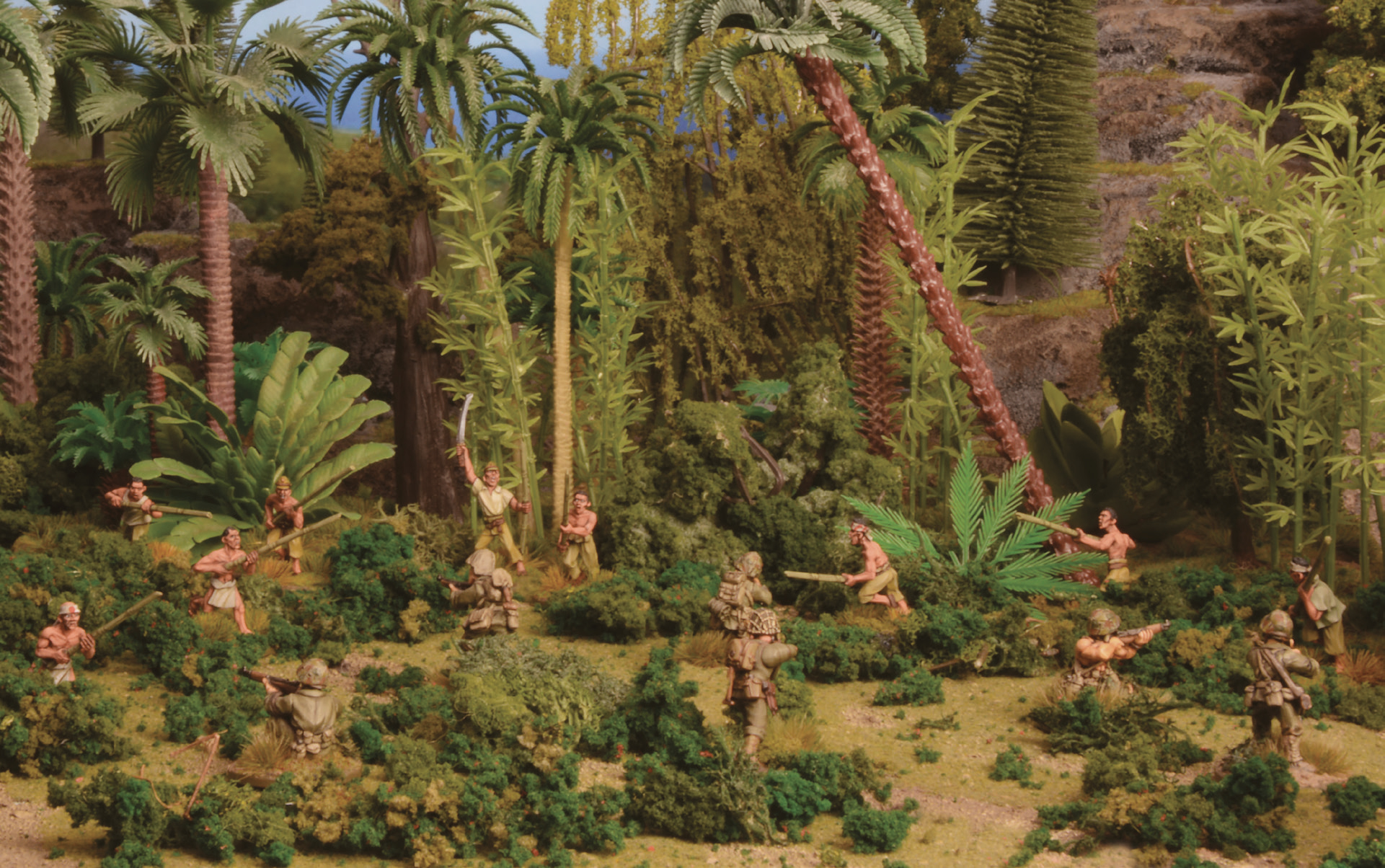
The Scenario
Forces
This scenario represents units from the 24th Marines chosen from the Marine selector for Saipan/Tinian.
The Japanese defenders are chosen from the Japanese Tinian selector. This force has a third of the points of the US player but also has one concrete block house, two concrete pill boxes, three earthen emplacements and three anti-tank minefields.
Set-Up
The US player sets up one quarter of the way in from his table edge. US units cannot Outflank. Snipers, scouts and forward observers may Forward Deploy.
The Japanese player sets up in his half of the table and uses the Hidden Set-up rules in the main rulebook and places a token to represent a unit plus six dummies that are placed on the table with a note of what the unit represents and the fortification they are in. The player could use pieces of paper explaining what the units are, written on the reverse. If the force is particularly large, increase the number of dummies in proportion so for 1,250 points add an extra dummy and for 1,500 add three dummy counters, etc. Japanese units cannot Outflank. Snipers, scouts and forward observers may Forward Deploy.
The US player before setting up his units has a Preparatory Bombardment to represent the naval bombardment. The Preparatory Bombardment is described in the main rules but always happens. The Dug-in vs Preparatory Bombardment rule means the Japanese do not get any modifier for being in cover.
After this there is a Preliminary Airstrike by a regular armed P-47 fighter with rockets which makes a final ground attack run on the Japanese forces using the Special Rules. It may expose some Japanese units at this stage.
Map
This game could be played on two 6ft x 4ft tables but when played on a single table it may be best to have the 4ft side as the width which the player sets up upon.
On the US player side of the table is a ridge. Just below this is an airfield and a fairly flat valley. The remains of Tinian Town would appear on a large table on the extreme right. On the Japanese side is a high hill with single road going up it on a small table, but on a big table there are two. Some of the sides are sheer and are impassable even to infantry. The Japanese have built emplacements in parts of the valley, on the slopes and ridge top.
Special Rules Used
Hidden Set-up Rules with Dummy Units; Preliminary Airstrike; Dug In; Dug in vs Preparatory Bombardmen; Japanese Spider Hole Networks; Dug in Against Tanks
Objective
The US Marine player is trying to take the ridge top. The Japanese player is trying to destroy the marines before they can reach the objective.
Duration
Duration partly depends on the number of points being used. The game could end on turn 10 for 1,000 points, turn 11 for 1,500 points or turn 12 for 2,000 points. At the end of this turn roll a dice and on a roll of 1-3 the game ends but on 4-6 play one further turn.
Victory!
At the end of the game calculate which side has won by adding up victory points as follows. If one side scores at least two more victory points than the other, that side has won a clear victory. Otherwise the result is deemed too close to call and honours are shared – a draw!
The US Marine player scores one point for each Japanese unit destroyed and one point if units are on the opposite hill slope. The US Marine player also scores three points for every US unit actually on the top of the hill at the end of the game.
The Japanese player score one point for each US Marine unit destroyed and two points for US Marine Command unit destroyed. The Japanese player scores one point for every unit still on the hill top at the end of the game.
The Aftermath
A prisoner from the 56th Naval Guard Force, Warrant Officer Akiyama, told his captors that at the time of capture on the 29 July, the southern redoubt held as many as 6,000 survivors, many of whom were civilians. The principal unit was the 50th Infantry with about 1,800 men. There were also some 500 men from the 56th Naval Guard Force and also remnants of other naval units. This meant that these units had taken about 50% casualties by 29 July.
General Schmidt’s operation order issued at 1730 on 30 July was “to annihilate the opposing Japanese”, now cornered in southern Tinian. The two divisions, jumping off at 0830, 31 July were to seize O-8, the southeast coastline between Lalo Point and Marpo Point. The 4th Marine Division led off with its 23rd and 24th Marines, while alongside, the 2nd Marine Division advanced with mixed battalions in line.
The 1st Battalion, 24th Marines moved out across a flat coastal plain where cane fields, brush, rocks, and a railroad track embankment hampered tank operations and gave concealment to a defended position along the beach in this area. LVT(A)’s rendered valuable fire support by moving along in the water, abreast of the right flank. Resistance became more stubborn at 0945 as the 1st Battalion closed upon an estimated platoon of Japanese soldiers who held a fortified position. As the marines closed in the Japanese troops launched a wild counterattack and they were rapidly eliminated. Vegetation masked the deep caves and fissures where Japanese riflemen and machine gunners were waiting. The flamethrower tanks were able to remove some of the thick growth that provided the enemy with cover and concealment.
The 3rd Battalion, 24th Marines moved alongside against sporadic rifle and automatic weapons fire. This progress continued until the battalion approached the cliff face. Here, at about 1630, it was hit with a storm of small-arms fire that halted all forward progress. Tanks from Company B, 4th tank Battalion and armoured half-tracks of the Regimental Weapons Company came forward to give support but found their movement blocked by a Japanese minefield and roadblocks which they could not bypass. Marine engineers from the 20th Marine came forward and removed them but it was now too late in the day for the 24th Marines to advance and they dug in.
On the left, the 2nd Marine Division attacked with three regiments abreast. As the cliff facing the 2nd Division in the left and centre was almost impossible to climb, their purpose was to move to the base of the cliff and remain in position on the O-8 Line to prevent Japanese escape along the east coast. The two left regiments, 2nd and 6th Marines, moved forward to the base of the cliff against only light rifle and machine gun fire. The 8th Marines’ path was up a double-hairpin and by late afternoon one company had reached the top of the cliff, followed after dark by most of the 1st and 2nd Battalions . Tanks were asked for but one hit a mine moving up the road and it was believed impassable to heavy vehicles. In fact the tank in the dark had hit the mine off the road near the cliff base. The Japanese reaction was to counterattack before they could hold no longer. This drove one portion of the marine line off the plateau.
Two half-track SPMs managed to get to the top of the cliff and tried to eliminate a troublesome enemy automatic weapons position to the front of the 2nd Battalion. Each time they tried to move forward they received Japanese knee mortar fire and were forced to withdraw to a rear position. Two 37mm guns were dug in and barbed wire was strung out. As night fell, there was a gap of 600 yards on the right and one of 350 yards on the left between the 8th Marine battalions on top of the cliff. Machinegun and mortar fire was brought down on the remaining marines but it failed to force them to withdraw and some defensive positions were just under the lip of the cliff to give cover.
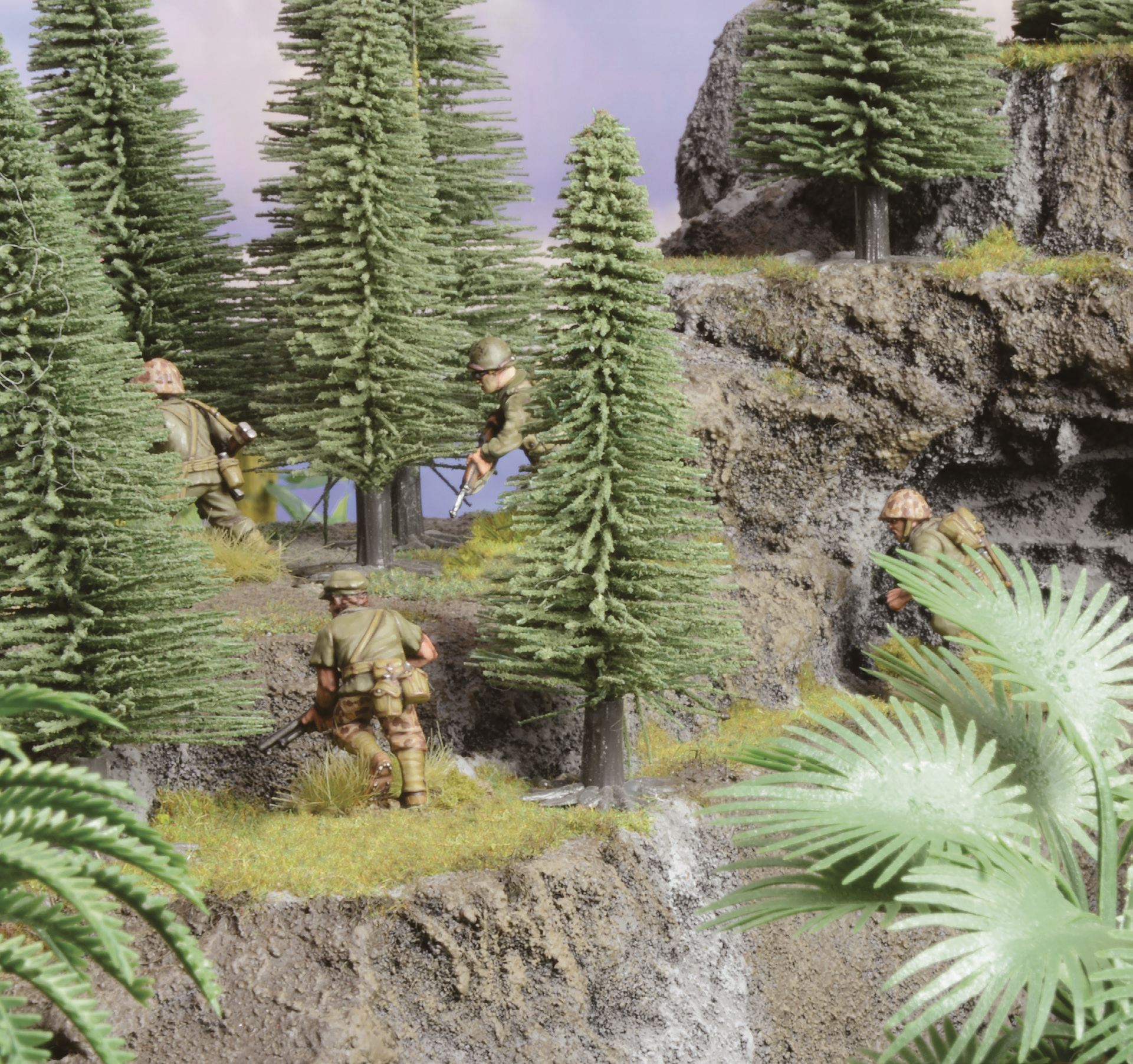 Early on a gap had opened between the 23rd Marines and the 2nd Marine Division. Upon arrival at the cliff they also faced heavy small-arms fire from both the cliff and a small village at the base of the cliff. When trying to continue their advance the regiment was taken under fire by what was reported to be a five-inch naval gun. Two Shermans were badly damaged by a 47mm gun in a concrete bunker with a narrow lane of fire which supported an infantry strongpoint. One battered tank fired a smoke shell in front of the gun, while the other tank manoeuvred behind the gun, knocked it out, and killed about 20 Japanese running out of the emplacement.
Early on a gap had opened between the 23rd Marines and the 2nd Marine Division. Upon arrival at the cliff they also faced heavy small-arms fire from both the cliff and a small village at the base of the cliff. When trying to continue their advance the regiment was taken under fire by what was reported to be a five-inch naval gun. Two Shermans were badly damaged by a 47mm gun in a concrete bunker with a narrow lane of fire which supported an infantry strongpoint. One battered tank fired a smoke shell in front of the gun, while the other tank manoeuvred behind the gun, knocked it out, and killed about 20 Japanese running out of the emplacement.
The 2nd Battalion, 23rd Marines had come up against a minefield protecting an approach road to the escarpment fronting the cliff. Engineers of Company C, 20th Marines were called forward to deal with the mines but came under small arms fire from close range. Supporting tanks began to advance to force the Japanese from their positions. The lead tank hit a mine which disabled it and wounded three of the crew. This encouraged the Japanese, who became more aggressive. A tank managed to move up behind and rescue the crew. The Japanese set up machineguns in the wrecked tank but other Marine tanks blew this tank to pieces.
The regimental halftrack platoon of the 23rd Marines had been moving behind the front lines to give ready support. When some of these weapons were within 200 yards of the cliff they were taken under fire by Japanese automatic weapons and one halftrack was knocked out. Sergeant John G. Benkovich led a group forward to recover the damaged vehicle but when he found he could not, he removed the gun’s breechblock but was seriously wounded. Benkovich was awarded the Silver Star for this action. Pharmacist’s mate Charles B. Stout was a Navy Corpsman serving with the 4th Marine Division. He was posthumously awarded the Navy Cross for repeatedly moving forward under fire to aid wounded marines on both Tinian and Saipan. By this time it was getting dark and the 24th Marines, alongside the 2nd Battalion, 23rd Marines, dug in where they were and put barbed wire across their front. Two battalions were on top of the escarpment without tank support.
The Japanese counterattack came at 2300, first striking against the 8th Marines, but it was repulsed. Three hours later a Japanese force numbering around 150 suddenly rushed down the hairpin road, up which the marines had been trying to carry ammunition and other supplies. Here the Japanese force set up a roadblock, burned two ambulance jeeps, and threatened to cut off the two American battalions on top of the plateau. An hour later a platoon of Japanese troops moved up the road and attacked Company F from the rear. After a hand to hand fight they were driven back and their roadblock was eliminated. Twice the two half-tracks moved forward and opened fire on suspected enemy assembly areas, but each time they were driven back by concentrated Japanese fire. For the next three hours mortars and field artillery kept the Japanese at bay, but at 0515 came the final banzai charge by around 700 troops. Illumination rounds turned night into day and 37mm canister rounds cut the attackers down. For a full half hour the attackers charged the marine lines, but at no point did they penetrate. The two 37mm guns were pushed forward and opened a deadly fire using canister rounds. Eight of the ten gunners were shot through the paper thin gunshields but were replaced by other marines. Daybreak revealed over a hundred Japanese dead in an area only about 70 yards square.
Some accounts have Colonel Ogata personally leading the counterattack. According to one Japanese prisoner of war, Ogata was killed during the charge by American machine guns and was last seen hanging dead over the marine’s barbed wire. However, other prisoners say he died a few days later in the last attack on the Americans. The entire counterattacking force had numbered between 600 and 800. This death toll doomed the final defence.
On 1 August more tanks and marines were moved onto the plateau but were still opposed by Japanese troops on a terraced ridge. A group of 50 tightly packed Japanese were cut down by Marine machine guns. By 1715 the 1st and 3rd Battalions reached the point of farthest possible coordinated advance, a cliff line cutting perpendicularly across the regiment’s zone of action and dipping sharply to a coastal plateau. Lieutenant General Schmidt declared the island secure at 1855. However, many Japanese were hiding in these southern shoreline cliff caves and could counterattack from them.
Three such counterattacks occurred on the night of 1-2 August. The fiercest struck the 3rd battalion, 6th Marines command post and Colonel Easley was one of the casualties. Some 119 Japanese dead were counted on the battlefield the following day. A counterattack by 150 Japanese was made on 2-3 August against the 6th Marines and some 124 bodies were found the next day. In these encounters the Japanese used explosive-filled sake bottles as improvised hand grenades. According to some Japanese prisoners Ogata was killed in this action. His body was never identified.
Private First Class Robert Lee Wilson was leading a patrol of BAR men to clear a group of boulders on 4 August, when a Japanese grenade landed in the midst of the team. Without hesitation, Private First Class Wilson yelled a warning to his men and then threw himself on the grenade, absorbing the full blast with his body. Wilson was awarded a posthumous Medal of Honour.
Small groups continued to attack for some time. Some Japanese stayed in their caves waiting for the marines to enter or for them to be buried alive. Thousands of safe passage and surrender leaflets were dropped and although some Japanese civilians surrendered, few soldiers did. After the respected Japanese manager of the largest sugar mill on the island had addressed the Japanese in the caves, encouraging them to surrender, some civilians came out and blew themselves up and some more jumped off the cliffs. Some sources claim the Japanese military threw some civilians off the cliffs and placed explosive charges on the civilians.
Begin your Island-Hopping Campaign
This new campaign supplement for Bolt Action allows players to recreate the historic island-hopping battles between US and Imperial Japanese forces in the Pacific theatre that took place in 1944. Even whilst the Allies stormed the beaches of Normandy, US forces were beginning to sweep across the Pacific in their own Blitzkrieg, fighting embittered and ferocious battles across tiny strips of land against tenacious Japanese defenders.
Or consider our Island hopping starter army bundles, perfect for quickly assembling a dependable core army for assaulting or defending the islands of both the Marianas and the Palaus.


